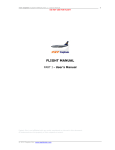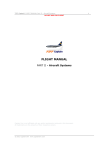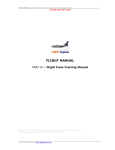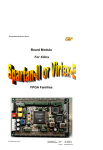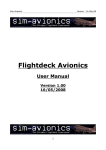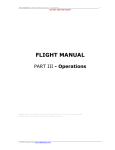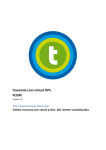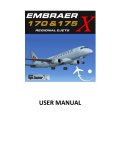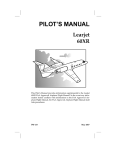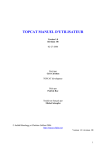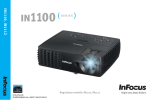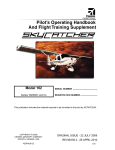Download Normal Procedures
Transcript
‘737 Captain’ FLIGHT MANUAL Part III –Normal Procedures DO NOT USE FOR FLIGHT FLIGHT MANUAL PART III - Normal Procedures Captain Sim is not affiliated with any entity mentioned or pictured in this document. All trademarks are the property of their respective owners. © 2012 Captain Sim www.captainsim.com 1 ‘737 Captain’ FLIGHT MANUAL Part III –Normal Procedures DO NOT USE FOR FLIGHT 2 ABOUT THIS MANUAL VERSION: 04 MAY, 2012 WARNING: THIS MANUAL IS DESIGNED FOR MICROSOFT® FSX USE ONLY. DO NOT USE FOR FLIGHT. The ‘737 Captain’ FLIGHT MANUAL is organized into four Parts: Each Part is provided as a separate Acrobat® PDF document: Click START > Programs > Captain Sim > 737 Captain > • Part I – User’s Manual o The User’s Manual describes the ‘737 Captain’ Sim product as a software title. • Part II – Aircraft Systems • Part III – Normal Procedures - this document • Part IV – Flight Crew Training Manual Adobe Acrobat® Reader Required FOR GENERAL INFORMATION ON THE ‘737 CAPTAIN’ PRODUCT PLEASE USE WWW.CAPTAINSIM.COM . THIS MANUAL PROVIDES ADDITIONAL INFORMATION ONLY, WHICH IS NOT AVAILABLE ON THE WEB SITE. © 2012 Captain Sim www.captainsim.com ‘737 Captain’ FLIGHT MANUAL Part III –Normal Procedures DO NOT USE FOR FLIGHT 737 Captain FLIGHT MANUAL PART III - CONTENTS 3 OPERATING LIMITATIONS 5 5 5 5 6 6 6 7 7 7 7 WEIGHT LIMITATIONS 737-200 AIRPLANES AIR SYSTEMS ANTI-ICE, RAIN AUTOPILOT ELECTRICAL POWER ENGINES APU FLIGHT CONTROLS FLIGHT MANAGEMENT, NAVIGATION FUEL LANDING GEAR 8 NORMAL PROCEDURES: INTRODUCTION 8 8 9 10 11 12 NORMAL PROCEDURES PHILOSOPHY AND ASSUMPTIONS CREW DUTIES SCAN FLOW AND AREAS OF RESPONSIBILITY PREFLIGHT AND POSTFLIGHT SCAN FLOW AREAS OF RESPONSIBILITY - CAPTAIN AS PILOT FLYING OR TAXIING AREAS OF RESPONSIBILITY - FIRST OFFICER AS PILOT FLYING OR TAXIING 13 NORMAL PROCEDURES: AMPLIFIED PROCEDURES 13 13 17 22 24 26 26 27 28 30 31 32 33 33 34 35 36 37 38 39 PRELIMINARY PREFLIGHT PROCEDURE - CAPTAIN OR FIRST OFFICER EXTERIOR INSPECTION PREFLIGHT PROCEDURE - FIRST OFFICER PREFLIGHT PROCEDURE - CAPTAIN BEFORE START PROCEDURE PUSHBACK OR TOWING PROCEDURE ENGINE START PROCEDURE BEFORE TAXI PROCEDURE BEFORE TAKEOFF PROCEDURE TAKEOFF FLAP RETRACTION SPEED SCHEDULE CLIMB AND CRUISE PROCEDURE DESCENT PROCEDURE APPROACH PROCEDURE FLAP EXTENSION SCHEDULE LANDING PROCEDURE GO-AROUND AND MISSED APPROACH PROCEDURE LANDING ROLL PROCEDURE AFTER LANDING PROCEDURE SHUTDOWN PROCEDURE SECURE PROCEDURE 40 CUSTOMER CARE 40 SPECIAL THANKS TO © 2012 Captain Sim www.captainsim.com 3 ‘737 Captain’ FLIGHT MANUAL Part III –Normal Procedures DO NOT USE FOR FLIGHT 4 OPERATING LIMITATIONS This chapter contains Airplane Flight Manual (AFM) limitations and Boeing recommended operating information. Limitations that are obvious, shown on displays or placards, or incorporated within an operating procedure are not contained in this chapter. Runway slope +/- 2% Maximum Takeoff and Landing Tailwind Component Maximum speeds 15 knots Turbulent airspeed 280 KIAS/.70M Mach trim inoperative max speed .74M Maximum Operating Altitude 37,000 feet Maximum Takeoff and Landing Altitude 8,300 feet Observe Vmo pointer gear/ flap placards and Verify that an operational check of the flight deck door access system (as installed) has been accomplished according to approved procedures once each flight day. On revenue flights, the escape slide retention bar (girt bar) must be installed during taxi, takeoff and landing. © 2012 Captain Sim www.captainsim.com ‘737 Captain’ FLIGHT MANUAL Part III –Normal Procedures DO NOT USE FOR FLIGHT 5 WEIGHT LIMITATIONS 737-200 AIRPLANES CHARACTERISTICS 737-200 TAKEOFF WEIGHT, POUNDS 737-100 737-200ADV 737-200C/F 116,000 111,000 128,100 116,000 ZERO FUEL WEIGHT, POUNDS 95,000 90,000 95,000 95,000 OPERATING EMPTY WEIGHT, POUNDS 59,800 62,000 65,700 65,700 AIR SYSTEMS The maximum cabin differential pressure (relief valves) is 8.65 psi. ANTI-ICE, RAIN Engine TAI must be on when icing conditions exist or are anticipated, except during climb and cruise below -40°C SAT. Minimum N1 RPM for operating in icing conditions except for landing: 40% when TAT between 0° and 10°C; 55% when TAT below 0°C; 70% in moderate to severe icing conditions when TAT below -6.5°C. Window heat inop: max speed 250 KIAS below 10,000 ft. AUTOPILOT Use of autopilot not authorized for takeoff or landing. Do not use autopilot roll channel above 30,000 feet with yaw damper inoperative. Do not use autopilot pitch channel above .81M with hydraulic system A or B depressurized. ELECTRICAL POWER Max engine driven generator load: 111 amps. Maximum generator drive oil temperature: 157° C © 2012 Captain Sim www.captainsim.com ‘737 Captain’ FLIGHT MANUAL Part III –Normal Procedures DO NOT USE FOR FLIGHT 6 ENGINES ENGINE LIMIT DISPLAY MARKINGS Maximum and minimum limits are red. Caution limits are amber. GENERAL ENGINE LIMITATIONS Maximum N1 RPM 100.1% Maximum N2 RPM 100 % Maximum Acceleration EGT (2 minutes) 580° C Maximum Takeoff EGT (5 minutes) 580° C Maximum Continuous EGT 540° C Maximum Start EGT Ambient Temperature above 15°C (momentary) Ambient Temperature below 15°C Maximum Oil Temperature (continuous) (15 minutes) 420° C 350° C 120° C 121° C 157° C OIL PRESSURE Maximum Oil Pressure 55 psi Minimum Oil Pressure 40 psi ENGINE IGNITION Engine ignition must be on during takeoff and landing. REVERSE THRUST Intentional selection of reverse thrust in flight is prohibited. APU Maximum start EGT is 760° C. Maximum continuous EGT is 710° C. With APU bleed + electrical load, maximum altitude is 10,000 ft. With APU bleed, maximum altitude is 17,000 ft. With APU electrical load, maximum altitude is 35,000 ft. APU bleed valve must be closed when: • ground air connected and isolation valve open • engine no. 1 bleed valve open • isolation valve and engine no. 2 bleed valve open. APU bleed valve may be open during engine start, but avoid engine power above idle. © 2012 Captain Sim www.captainsim.com ‘737 Captain’ FLIGHT MANUAL Part III –Normal Procedures DO NOT USE FOR FLIGHT 7 FLIGHT CONTROLS Flap extension altitude is 20,000 ft. In flight, do not extend the SPEED BRAKE lever beyond the FLIGHT DETENT. Avoid rapid and large alternating control inputs, especially in combination with large changes in pitch, roll, or yaw (e.g. large side slip angles) as they may result in structural failure at any speed, including below VA. FLIGHT MANAGEMENT, NAVIGATION Do not operate the weather radar in a hangar or within 50 feet of fueling operations or fuel spills. Do not operate the weather radar within 160 feet of personnel. Warm up radar in STBY position only. FUEL Do not reset a tripped fuel pump circuit breaker. Maximum fuel temperature is 49° C. Minimum fuel temperature is fuel freeze point +3° C or -45° C, whichever is higher. FUEL LOADING On the ground, main tanks 1 and 2 must be full if center tank contains more than 1000 lbs. LANDING GEAR Do not apply brakes until after touchdown. © 2012 Captain Sim www.captainsim.com ‘737 Captain’ FLIGHT MANUAL Part III –Normal Procedures DO NOT USE FOR FLIGHT 8 NORMAL PROCEDURES: INTRODUCTION This chapter gives: • an introduction to the normal procedures philosophy and assumptions • step by step normal procedures NORMAL PROCEDURES PHILOSOPHY AND ASSUMPTIONS Normal procedures verify for each phase of flight that: • the airplane condition is satisfactory • the flight deck configuration is correct Normal procedures are done on each flight. Refer to the Supplementary Procedures (SP) chapter for procedures that are done as needed, for example the adverse weather procedures. Normal procedures are used by a trained flight crew and assume: • all systems operate normally • the full use of all automated features. Normal • • • procedures also assume coordination with the ground crew before: hydraulic system pressurization, or flight control surface movement, or airplane movement Normal procedures do not include steps for flight deck lighting and crew comfort items. Normal procedures are done by recall and scan flow. The panel illustration in this section shows the scan flow. The scan flow sequence may be changed as needed. CREW DUTIES Preflight and postflight crew duties are divided between the captain and first officer. Phase of flight duties are divided between the Pilot Flying (PF) and the Pilot Monitoring (PM.) Each crewmember is responsible for moving the controls and switches in their area of responsibility: • The phase of flight areas of responsibility for both normal and non-normal procedures are shown in the Area of Responsibility illustrations in this section. Typical panel locations are shown. • The preflight and postflight areas of responsibility are defined by the "Preflight Procedure Captain" and "Preflight Procedure - First Officer". The captain may direct actions outside of the crewmember's area of responsibility. The general PF phase of flight responsibilities are: • taxiing • flight path and airspeed control • airplane configuration • navigation The general PM phase of flight responsibilities are: • checklist reading • communications • tasks asked for by the PF • monitoring taxiing, flight path, airspeed, airplane configuration, and navigation PF and PM duties may change during a flight. For example, the captain could be the PF during taxi but be the PM during takeoff through landing. Normal procedures show who does a step by crew position (C, F/O, PF, or PM): • in the procedure title, or • in the far right column, or © 2012 Captain Sim www.captainsim.com ‘737 Captain’ FLIGHT MANUAL Part III –Normal Procedures DO NOT USE FOR FLIGHT • in the column heading of a table 9 The mode control panel is the PF's responsibility. When flying manually, the PF directs the PM to make the changes on the mode control panel. The captain is the final authority for all tasks directed and done. SCAN FLOW AND AREAS OF RESPONSIBILITY The scan flow and areas of responsibility diagrams shown below are representative and may not match the configuration of your airplane. The scan flow diagram provides general guidance on the order of each flight crew member should follow when doing the preflight procedures. Specific guidance on the items to be checked are detailed in the amplified Normal Procedures, Preflight Procedure - Captain and Preflight Procedure - First Officer. © 2012 Captain Sim www.captainsim.com ‘737 Captain’ FLIGHT MANUAL Part III –Normal Procedures DO NOT USE FOR FLIGHT PREFLIGHT AND POSTFLIGHT SCAN FLOW © 2012 Captain Sim www.captainsim.com 10 ‘737 Captain’ FLIGHT MANUAL Part III –Normal Procedures DO NOT USE FOR FLIGHT AREAS OF RESPONSIBILITY - CAPTAIN AS PILOT FLYING OR TAXIING © 2012 Captain Sim www.captainsim.com 11 ‘737 Captain’ FLIGHT MANUAL Part III –Normal Procedures DO NOT USE FOR FLIGHT AREAS OF RESPONSIBILITY - FIRST OFFICER AS PILOT FLYING OR TAXIING © 2012 Captain Sim www.captainsim.com 12 ‘737 Captain’ FLIGHT MANUAL Part III –Normal Procedures DO NOT USE FOR FLIGHT 13 NORMAL PROCEDURES: AMPLIFIED PROCEDURES PRELIMINARY PREFLIGHT PROCEDURE - CAPTAIN OR FIRST OFFICER The Preliminary Preflight Procedure assumes that the Electrical Power Up supplementary procedure is complete. Electronic master switches ……………………………………………………… ON Circuit breakers (P6 panel) …………………………………………………….. Check Circuit breakers (P18 panel)…………………………………………………… Check Parking brake …………………………………………………………………………. As needed EXTERIOR INSPECTION Before each flight the captain, first officer, or maintenance crew must verify that the airplane is satisfactory for flight. Items at each location may be checked in any sequence. Use the • • • • • • • • • detailed inspection route below to check that: the surfaces and structures are clear, not damaged, not missing parts and there are no fluid leaks the tires are not too worn, not damaged, and there is no tread separation the gear struts are not fully compressed the engine inlets and tailpipes are clear, the access panels are secured, the exterior is not damaged, and the reversers are stowed the the the the the doors and access panels that are not in use are latched probes, vents, and static ports are clear and not damaged skin area adjacent to the pitot probes and static ports is not wrinkled antennas are not damaged light lenses are clean and not damaged INSPECTION ROUTE © 2012 Captain Sim www.captainsim.com ‘737 Captain’ FLIGHT MANUAL Part III –Normal Procedures DO NOT USE FOR FLIGHT LEFT FORWARD FUSELAGE Probes, sensors, ports, vents, and drains (as applicable)......................Check Doors and access panels (not in use)............................................Latched Main deck cargo door (as installed)....................................................Check NOSE Radome.........................................................................................Check Conductor straps - Secure Forward E and E door...................................................................Secure NOSE WHEEL WELL Tires and wheels.............................................................................Check Exterior light................................................................................Check Gear strut and doors........................................................................Check View port.......................................................................Clear and clean Nose wheel steering assembly...........................................................Check RIGHT FORWARD FUSELAGE Probes, sensors, ports, vents, and drains (as applicable)....................Check Doors and access panels (not in use)............................................Latched RIGHT WING ROOT, PACK, AND LOWER FUSELAGE Ram air deflector door...............................................................Extended Pack and pneumatic access doors...................................................Secure Probes, sensors, ports, vents, and drains (as applicable)......................Check Exterior lights...............................................................................Check Leading edge flaps........................................................................Check NUMBER 2 ENGINE Access panels...........................................................................Latched Probes, sensors, ports, vents, and drains (as applicable)....................Check Fan blades, probes, and spinner.....................................................Check © 2012 Captain Sim www.captainsim.com 14 ‘737 Captain’ FLIGHT MANUAL Part III –Normal Procedures DO NOT USE FOR FLIGHT Thrust reversers........................................................................Stowed Exhaust area and tailcone..............................................................Check RIGHT WING AND LEADING EDGE Leading edge slats......................................................................Check Wing Surfaces............................................................................Check RIGHT WING TIP AND TRAILING EDGE Position lights...............................................................................Check Static discharge wicks...................................................................Check Aileron and trailing edge flaps......................................................Check Exterior lights ………………………………………………………………………………… Check RIGHT MAIN GEAR Tires, brakes and wheels..............................................................Check Verify that the wheel chocks are in place as needed. Gear strut, actuators, and doors...................................................Check Hydraulic lines...........................................................................Secure RIGHT MAIN WHEEL WELL View port.....................................................................………………. Clear and clean Wheel well....................................................................................Check RIGHT AFT FUSELAGE Doors and access panels (not in use)..........................................Latched Negative pressure relief door.......................................................Closed Outflow valve…………………………………………………………………………………….. Check Probes, sensors, ports, vents, and drains (as applicable)....................Check APU air inlet..................................................................................Open © 2012 Captain Sim www.captainsim.com 15 ‘737 Captain’ FLIGHT MANUAL Part III –Normal Procedures DO NOT USE FOR FLIGHT TAIL Vertical stabilizer and rudder........................................................Check Elevator feel probes....................................................................Check Horizontal stabilizer and elevator..................................................Check Static discharge wicks.................................................................Check APU exhaust outlet.....................................................................Check Verify that there is no indication of scorch marks on the outlet. LEFT AFT FUSELAGE Doors and access panels (not in use)..........................................Latched Probes, sensors, ports, vents, and drains (as applicable).................Check LEFT MAIN WHEEL WELL View port......................................................................Clear and clean Wheel well.................................................................................Check LEFT MAIN GEAR Tires, brakes and wheels.............................................................Check Verify that the wheel chocks are in place as needed. Gear strut, actuators and doors....................................................Check Hydraulic lines...........................................................................Secure LEFT WING TIP AND TRAILING EDGE Aileron and trailing edge flaps........................................................Check Static discharge wicks...................................................................Check Position lights...............................................................................Check Exterior lights...............................................................................Check © 2012 Captain Sim www.captainsim.com 16 ‘737 Captain’ FLIGHT MANUAL Part III –Normal Procedures DO NOT USE FOR FLIGHT LEFT WING AND LEADING EDGE Wing Surfaces..............................................................................Check Leading edge slats........................................................................Check NUMBER 1 ENGINE Exhaust area and tailcone..............................................................Check Thrust reversers.......................................................................Stowed Fan blades, probes, and spinner.....................................................Check Probes, sensors, ports, vents, and drains (as applicable)....................Check Access panels..........................................................................Latched LEFT WING ROOT, PACK, AND LOWER FUSELAGE Leading edge flaps……………………………………………………………………. Check Probes, sensors, ports, vents, and drains (as applicable)....................Check Exterior lights...............................................................................Check PREFLIGHT PROCEDURE - FIRST OFFICER The first officer normally does this procedure. The captain may do this procedure if needed. Flight control panel ……………………………………………………………………. Check FLIGHT CONTROL switches - Guards closed Flight SPOILER switches - Guards closed YAW DAMPER switch - ON NAV transfer switches...........................................................NORMAL Verify that the FUEL VALVE CLOSED lights are illuminated dim. Verify that the FILTER ICING lights are extinguished. Fuel HEAT switches – OFF Verify that the VALVE OPEN lights are extinguished. CROSSFEED selector – CLOSED Verify that the VALVE OPEN light is extinguished. FUEL PUMP switches – OFF Verify that the center tank fuel pump LOW PRESSURE lights are extinguished. © 2012 Captain Sim www.captainsim.com 17 ‘737 Captain’ FLIGHT MANUAL Part III –Normal Procedures DO NOT USE FOR FLIGHT 18 Verify that the auxiliary tank fuel pump LOW PRESSURE lights (as installed) are extinguished. Verify that the main tank fuel pump LOW PRESSURE lights are illuminated. Electrical panel................................................................................Set BATTERY switch - Guard closed GALLEY power switch - ON STANDBY POWER switch - Guard closed Verify that the STANDBY PWR OFF light is extinguished. Generator drive DISCONNECT switches - Guards closed Verify that the LOW OIL PRESSURE lights are illuminated. Verify that the HIGH OIL TEMP lights are extinguished. DRIVE TEMPERATURE switch - As needed BUS TRANSFER switch - Guard closed Verify that the TRANSFER BUS OFF lights are extinguished. Verify that the BUS OFF lights are extinguished. Verify that the GEN OFF BUS lights are illuminated. Overheat and fire protection panel (Passenger airplanes) APU switch (as needed).............................................................START When the APU GEN OFF BUS light is illuminated: APU GENERATOR bus switches – ON Verify that the BUS OFF lights are extinguished. Verify that the TRANSFER BUS OFF lights are extinguished. Verify that the LOW OIL QUANTITY light is extinguished. Verify that the APU LOW OIL PRESSURE light is extinguished. Verify that the APU HIGH OIL TEMP light is extinguished. Verify that the APU OVERSPEED light is extinguished. EQUIPMENT COOLING switch.................................................NORMAL Verify that the OFF light is extinguished. EMERGENCY EXIT LIGHTS switch...........................................Guard closed Verify that the NOT ARMED light is extinguished. Passenger signs...................................................................Set NO SMOKING switch - AUTO or ON © 2012 Captain Sim www.captainsim.com Check ‘737 Captain’ FLIGHT MANUAL Part III –Normal Procedures DO NOT USE FOR FLIGHT FASTEN BELTS switch - AUTO or ON Windshield WIPER selector....................................................OFF If the windshield wipers are not stowed, place the selector to PARK then OFF. WINDOW HEAT switches.......................................................ON Position the switches ON at least 10 minutes before takeoff. Verify that the OVERHEAT lights are extinguished. Verify that the ON lights are illuminated except at high ambient temperatures. PITOT STATIC HEAT switches................................................OFF Verify that all PROBE HEATER lights are illuminated. WING ANTI-ICE switch.........................................................OFF Verify that the VALVE OPEN lights are extinguished. ENGINE ANTI-ICE switches....................................................OFF Verify that the VALVE OPEN lights are extinguished. Hydraulic panel.............................................................Set GROUND INTERCONNECT switch - CLOSE HYDRAULIC PUMPS switches - ON Verify that the LOW PRESSURE lights are illuminated. ELECTRIC HYDRAULIC PUMPS switches - OFF Verify that the OVERHEAT lights are extinguished. Verify that the LOW PRESSURE lights are illuminated. Cabin altitude panel .............................................................Set SMOKE CLEARANCE switch - Guard closed Air conditioning panel ...........................................................Set AIR TEMPERATURE source selector - As needed Verify that the DUCT OVERHEAT lights are extinguished. Temperature selectors - As needed Verify that the RAM DOOR FULL OPEN lights are illuminated. GASPER FAN switch - As needed Air conditioning PACK switches - Set One switch - ON Other switch - OFF ISOLATION VALVE switch - AUTO Engine BLEED air switches - ON APU BLEED air switch - ON Verify that the DUAL BLEED light is illuminated. © 2012 Captain Sim www.captainsim.com 19 ‘737 Captain’ FLIGHT MANUAL Part III –Normal Procedures DO NOT USE FOR FLIGHT 20 Verify that the PACK TRIP OFF lights are extinguished. Verify that the WING-BODY OVERHEAT lights are extinguished. Verify that the BLEED TRIP OFF lights are extinguished. Cabin pressurization panel ....................................................Set Verify that the AUTO FAIL light is extinguished. Verify that the OFF SCHED DESCENT light is extinguished. FAILURE ALTITUDE indicator - Cruise altitude LANDING ALTITUDE indicator - Destination field elevation CABIN RATE selector – Index CABIN ALTITUDE indicator - 200 feet below destination field elevation FLIGHT/GROUND switch - GRD Pressurization mode selector – AUTO Verify that the STANDBY light is extinguished. Verify that the MANUAL light is extinguished. Lighting panel....................................................................... Set LANDING light switches - RETRACT and OFF RUNWAY TURNOFF light switches - OFF TAXI light switch – OFF ENGINE START switches........................................................ OFF Lighting panel...................................................................... Set POSITION light switch - As needed ANTI-COLLISION light switch - OFF WING illumination switch - As needed WHEEL WELL light switch - As needed Flight director panel.............................................................. Set Mode selector – OFF ALTITUDE HOLD switch – OFF PITCH COMMAND control - Full clockwise Oxygen................................................................................ Test and set STATIC SOURCE SELECTOR switch………………………………………………………………NORMAL Marker beacon lights………………………………………………………………………………………..Test Clock…………………………………………………………………………..……………………………………..Set Autopilot disengage light…………………………………………………………………….. Push to test Verify that the AUTOPILOT disengage light is illuminated. Flight instruments…………………………………………………………………….. Check Set the altimeter. © 2012 Captain Sim www.captainsim.com ‘737 Captain’ FLIGHT MANUAL Part III –Normal Procedures DO NOT USE FOR FLIGHT 21 Verify that the flight instrument indications are correct. Verify that only these flags are shown: • TCAS (as installed) disengage light is illuminated. • expected RMI flags Hydraulic system B LOW QUANTITY light……………………………….. Verify extinguished SYSTEM A HYDRAULIC QUANTITY indicator…………………………………… Above RF GROUND PROXIMITY panel………………………………………………………… Check FLAP/GEAR INHIBIT switch - Guard closed Verify that the INOP light is extinguished. Landing gear panel…………………………………………………………………………………Set LANDING GEAR lever - DN Verify that the green landing gear indicator lights are illuminated. Verify that the red landing gear indicator lights are extinguished. TAKEOFF CONFIG light (as installed) ……………………………………………………Verify extinguished CABIN ALTITUDE light (as installed) …………………………………………………….Verify extinguished ANTISKID switches ……………………………………………………………………………… Guards closed Verify that the ANTISKID INOP lights are extinguished. AUTOBRAKE selector…………………………………………………………………………… OFF Verify that the AUTO BRAKE DISARM light is extinguished. EPR reference selectors (on PDCS equipped airplanes) ………………………Push Engine instruments………………………………………………………………………………. Check Verify that the REVERSER UNLOCKED lights are extinguished. Verify that the START VALVE OPEN lights are extinguished. Verify that the LOW OIL PRESSURE lights are illuminated. Verify that the OIL FILTER BYPASS lights are extinguished. Verify that the primary and secondary engine indications show existing conditions. ENGINE OIL QUANTITY TEST switch………………………………………………… Push Verify that the oil quantity indicators move toward zero and return to the original position when the switch is released. VHF communications radios ………………………………………………………… Set VHF NAVIGATION radios ……………………………………………………………… Set for departure Audio selector panel …………………………………………………………………… Set ADF radios…………………………………………………………………………………… Set WEATHER RADAR panel……………………………………………………………… © 2012 Captain Sim www.captainsim.com Set ‘737 Captain’ FLIGHT MANUAL Part III –Normal Procedures DO NOT USE FOR FLIGHT Transponder panel…………………………………………………………………. Set 22 STABILIZER BRAKE RELEASE knob ………………………………………Verify released WARNING: Do not put objects between the seat and the aisle stand. Injury can occur when the seat is adjusted. Seat…………………………………………………………………………………………Adjust Adjust the seat for optimum eye reference. Verify a positive horizontal (fore and aft) seat lock. Rudder pedals……………………………………………………………… Adjust Adjust the rudder pedals to allow full rudder pedal and brake pedal movement. Seat belt and shoulder harness………………………………… Adjust Do the PREFLIGHT checklist on the captain's command. PREFLIGHT PROCEDURE - CAPTAIN The captain normally does this procedure. The first officer may do this procedure if needed. Lights………………………………………………………………………… Set Flight director panel………………………………………………………… Set Mode selector - OFF ALTITUDE HOLD switch - OFF PITCH COMMAND control - Full clockwise Autopilot panel …………………………………………………………… Set Autopilot mode selector - MAN Autopilot system select switch - As needed Autopilot heading switch - Centered position Autopilot AILERON engage switch - DISENGAGED Autopilot ELEVATOR engage switch - DISENGAGED Autopilot pitch mode selector - OFF Oxygen ……………………………………………………………………… Test and set STATIC SOURCE SELECTOR switch …………………………………… NORMAL Marker beacon lights………………………………………………………… Test Clock………………………………………………………………………………………… Set Autopilot disengage light……………………………………………………… Push to test Verify that the AUTOPILOT disengage light is illuminated. Flight instruments…………………………………………………………………….. Check Set the altimeter Verify that the flight instrument indications are correct. © 2012 Captain Sim www.captainsim.com ‘737 Captain’ FLIGHT MANUAL Part III –Normal Procedures DO NOT USE FOR FLIGHT 23 Verify that only these flags are shown: • TCAS (as installed) • expected RMI flags Standby instruments………………………………………………………… Check Verify that the flight instrument indications are correct Verify that no flags are shown. STAB OUT OF TRIM light………………………………………………………… Verify extinguished SPEED BRAKE lever………………………………………………………… DOWN detent Verify that the SPEED BRAKE ARMED light is extinguished. Verify that the SPEED BRAKE DO NOT ARM light is extinguished. Reverse thrust levers………………………………………………………… Down Forward thrust levers………………………………………………………… Closed FLAP lever……………………………………………………………………. Set Set the flap lever to agree with the flap position. Parking brake……………………………………………………………... Set Verify that the parking brake warning light is illuminated Note: Do not assume that the parking brake will prevent airplane movement. Accumulator pressure can be insufficient. Engine start levers……………………………………………………………... CUTOFF STABILIZER TRIM cutout switches……………………………………… NORMAL VHF communications radios…………………………………………………… Set VHF NAVIGATION radios……………………………………………………… Set for departure Audio selector panel……………………………………………………………... Set WARNING: Do not put objects between the seat and the aisle stand. Injury can occur when the seat is adjusted. Seat………………………………………………………………………………………… Adjust Adjust the seat for optimum eye reference. Verify a positive horizontal (fore and aft) seat lock. Rudder pedals……………………………………………………………... Adjust Adjust the rudder pedals to allow full rudder pedal and brake pedal movement. Seat belt and shoulder harness…………………………………………… Call "PREFLIGHT CHECKLIST." © 2012 Captain Sim www.captainsim.com Adjust ‘737 Captain’ FLIGHT MANUAL Part III –Normal Procedures DO NOT USE FOR FLIGHT 24 BEFORE START PROCEDURE Start the Before Start Procedure after papers are on board. Flight deck door……………………………………………………………… Closed and locked F/O Verify that the CAB DOOR UNLOCKED light (as installed) is extinguished. Verify that the LOCK FAIL light (as installed) is extinguished. Do the Performance Data Computer System (as installed) Preflight Supplementary Procedure. PDCS CDU flight mode selector (as installed)...........As needed C, F/O Takeoff data........................................................Complete C, F/O Verify the takeoff data to include: • EPR • N1 • • • • • • • V1, VR, and V2 flap setting zero fuel weight temperature altimeter setting gross weight stabilizer trim setting Fuel quantity indicators...............................................Check C, F/O Verify that the fuel on the dispatch papers and fuel quantity indicators agree. Verify that the fuel is sufficient for flight. Note: Do not push the QUANTITY TEST switch when the airplane is being refueled. This will cause incorrect indications at the external fueling panel. Total fuel and VREF indicator............................................Set C Zero fuel weight - Set Flap selector - As needed Verify VREF on the VREF pointer. On airplanes without PDCS, EPR reference selectors...................................................Set C Verify that the EPR reference bugs and digital readouts are correct. On airplanes with PDCS, EPR reference selectors.....................................................In C Verify that the PDCS reference bugs and digital readouts are correct. IAS bugs.......................................................................Set C, F/O Set the speed bugs at V1, VR, V2 + 15, and flaps up maneuvering speed. Airspeed cursor controls............................................Set V2 C, F/O HSI HEADING selectors...................................................Set C, F/O © 2012 Captain Sim www.captainsim.com ‘737 Captain’ FLIGHT MANUAL Part III –Normal Procedures DO NOT USE FOR FLIGHT HSI course selectors.......................................................Set C, F/O ALTITUDE alert controller................................................Set Taxi and Takeoff briefings......................................Complete C C, F/O The pilot who will do the takeoff does the taxi and takeoff briefings. Exterior doors.................................................Verify closed F/O Flight deck windows.................................Closed and locked C, F/O Start clearance..........................................................Obtain C, F/O Obtain a clearance to pressurize the hydraulic systems. Obtain a clearance to start the engines. ANTI COLLISION light switch............................................ON F/O Trim.............................................................................Set C Check each trim for freedom of movement. Stabilizer trim -_____UNITS Set the trim for takeoff. Verify that the trim is in the green band. Aileron trim - 0 units Rudder trim - 0 units Call "BEFORE START CHECKLIST. C Do the BEFORE START checklist. F/O © 2012 Captain Sim www.captainsim.com 25 ‘737 Captain’ FLIGHT MANUAL Part III –Normal Procedures DO NOT USE FOR FLIGHT 26 PUSHBACK OR TOWING PROCEDURE The Engine Start procedure may be done during pushback or towing. Establish communications with ground handling personnel. C CAUTION: Do not hold or turn the nose wheel steering wheel during pushback or towing. This can damage the nose gear or the tow bar. CAUTION: Do not use airplane brakes to stop the airplane during pushback or towing. This can damage the nose gear or the tow bar. Set or release the parking brake as directed by ground handling personnel. C When pushback or towing is complete: Verify that the tow bar is disconnected C Verify that the nose gear steering lockout pin is removed C System A HYDRAULIC PUMPS switches - ON F/O ENGINE START PROCEDURE Air conditioning PACK switches.......................................OFF F/O Start pressure........................................................._____PSI F/O The minimum start pressure at sea level is 30 psi. Decrease the minimum start pressure 0.5 psi for each 1,000 feet above sea level. Start sequence....................................................Announce C Call "START______ENGINE" C ENGINE START switch..................................................GRD Verify that the N2 RPM increases. F/O C, F/O Verify that the oil pressure increases and call "OIL PRESSURE RISING" F/O When N1 rotation is seen and N2 is at 20%, or (if 20% N2 is not possible), at maximum motoring and a minimum of 15% N2: Engine start lever..................................................IDLE Monitor fuel flow and EGT indications. C C, F/O At 35-40% N2, verify that the ENGINE START switch moves to OFF. If not, move the ENGINE START switch to OFF. F/O Verify that the duct pressure increases when the ENGINE START switch moves to OFF. F/O Verify that the START VALVE OPEN light extinguishes when the ENGINE START switch moves to OFF. Call "STARTER CUTOUT " © 2012 Captain Sim www.captainsim.com F/O F/O ‘737 Captain’ FLIGHT MANUAL Part III –Normal Procedures DO NOT USE FOR FLIGHT 27 Monitor N1, N2, EGT, fuel flow and oil pressure for normal indications while the engine accelerates to a stable idle. C, F/O Do the ABORTED ENGINE START checklist for one or more of the following abort start conditions: - - there is no N1 rotation by 20% N2 there is no oil pressure increase by 30 seconds the fuel flow is greater than 1100 pph/500kgph at start the EGT does not increase by 20 seconds after the engine start lever is moved to IDLE the N1 or N2 does not increase or increases very slowly after the EGT increases - the EGT quickly nears or exceeds the start limit BEFORE TAXI PROCEDURE Fuel HEAT switches..............................................As needed F/O Before takeoff with tank fuel temperature 0° C or below, set the fuel HEAT switches to ON for one cycle. Fuel heat must be OFF for takeoff. GENERATOR 1 and 2 switches........................................ON F/O PITOT HEAT switches......................................................ON F/O WING ANTI-ICE switch..........................................As needed F/O ENGINE ANTI-ICE switches....................................As needed F/O Flight recorder REPEAT switch........................................Push F/O PACK switches...............................................................ON F/O ISOLATION VALVE switch...........................................AUTO F/O APU BLEED air switch....................................................OFF F/O Flight/Ground switch .....................................................FLT F/O APU switch...................................................................OFF F/O ENGINE START switches.......................................LOW IGN F/O Engine start levers............................................IDLE detent C Verify that the ground equipment is clear. C, F/O Call "FLAPS______" as needed for takeoff. C Flap lever...................................................Set takeoff flaps F/O Verify that the LE FLAPS EXT green light is illuminated. Make slow and deliberate inputs, one direction at a time. Move the control wheel and the control column to full travel in both directions and verify: • • freedom of movement that the controls return to center Hold the nose wheel steering wheel during the rudder check to prevent nose wheel movement. © 2012 Captain Sim www.captainsim.com ‘737 Captain’ FLIGHT MANUAL Part III –Normal Procedures DO NOT USE FOR FLIGHT Move the rudder pedals to full travel in both directions and verify: • • 28 freedom of movement that the rudder pedals return to center Transponder........................................................As needed Recall Check F/O C, F/O Verify that all system annunciator panel lights illuminate and then extinguish. Update changes to the taxi briefing, as needed. C or PF Call "BEFORE TAXI CHECKLIST " C Do the BEFORE TAXI checklist. F/O BEFORE TAKEOFF PROCEDURE Engine warm up recommendations (there is no need to delay the takeoff for these recommendations): When the engines have been shut down more than 2 hours: • • run the engine for 5 minutes • use a thrust setting normally used for taxi operations. when taxi time is expected to be less than 5 minutes, start the engines as early as feasible Pilot Flying Pilot Monitoring Notify the cabin crew to prepare for takeoff. Verify that the cabin is secure. The pilot who will do the takeoff updates changes to the takeoff briefing as needed. Set the weather radar display as needed. Call "BEFORE TAKEOFF CHECKLIST." Do the BEFORE TAKEOFF checklist. Pilot Monitoring Pilot Flying When entering the departure runway, use lights as needed. Verify that the brakes are released. Align the airplane with the runway. When cleared for takeoff, set the INBOARD LANDING light switches to ON. Set the transponder mode selector to TA/RA (as installed). Advance the thrust levers to approximately 1.4 EPR (levers in vertical position). Allow the engines to stabilize. Advance thrust levers to takeoff EPR. Verify that the correct takeoff thrust is set. Monitor the engine instruments during the takeoff. Call out any abnormal indications. Adjust takeoff thrust before 60 knots as needed. After takeoff thrust is set, the captain's hand must be on the thrust levers until V1. © 2012 Captain Sim www.captainsim.com ‘737 Captain’ FLIGHT MANUAL Part III –Normal Procedures DO NOT USE FOR FLIGHT Monitor airspeed. Monitor airspeed and call out any abnormal incitations. Maintain light forward pressure on the control column. Verify 80 knots and call "CHECK". Call "80 KNOTS." Verify V1 speed. Call "V1" At VR, rotate toward 15° pitch attitude. Establish a positive rate of climb. At VR call "ROTATE." Monitor airspeed and vertical speed. Verify a positive rate of climb on the altimeter and call "GEAR UP " Verify a positive rate of climb on the altimeter and call "POSITIVE RATE." Maintain a minimum of V2 + 15 to 25 after the initial climb is established. Set the landing gear lever to UP. At thrust reduction height, reduce thrust to approximately 90% N1 and call "SET CLIMB THRUST." Set climb EPR. Verify that climb thrust is set. At acceleration height, call "SET FLAPS SPEED." Set the flaps up maneuvering speed. Verify acceleration. Call "FLAPS " according to the flap retraction schedule. Set the FLAP lever as directed. Monitor flaps and slats retraction. After flap retraction is complete and above After flap retraction is complete: minimum altitude for autopilot Set or verify engine bleeds and air conditioning engagement: packs are operating • engage the autopilot. Set the engine start switches as needed Set the AUTOBRAKE selector to OFF. Set the landing gear lever to OFF after landing gear retraction is complete Call "AFTER TAKEOFF CHECKLIST." Do the AFTER TAKEOFF checklist. © 2012 Captain Sim www.captainsim.com 29 ‘737 Captain’ FLIGHT MANUAL Part III –Normal Procedures DO NOT USE FOR FLIGHT TAKEOFF FLAP RETRACTION SPEED SCHEDULE Takeoff Flaps At and Below Above 117,000 LB Select Flaps 117,000 LB 25 V2 + 15 V2 + 15 150 170 160 180 5 1 190 200 UP V2 + 15 170 V2 + 15 180 190 200 UP 5 or 2 V2 + 15 190 V2 + 15 200 1 UP 1 190 200 UP 15 or 10 Limit bank angle to 15° until reaching V2 + 15. © 2012 Captain Sim www.captainsim.com 15 5 1 30 ‘737 Captain’ FLIGHT MANUAL Part III –Normal Procedures DO NOT USE FOR FLIGHT CLIMB AND CRUISE PROCEDURE Complete the After Takeoff Checklist before starting the Climb and Cruise Procedure. Pilot Flying Pilot Monitoring At or above 10,000 feet MSL, set the LANDING light switches to OFF. Set the passenger signs as needed. At transition altitude, set and crosscheck the altimeters to standard. During climb, set both center tank fuel pump switches to OFF when both center tank fuel pump LOW PRESSURE lights illuminate. When established in a level flight attitude, if the center tank contains usable fuel and the center tank fuel pump switches are OFF, set both center tank fuel pump switches to ON again Set both center tank fuel pump switches to OFF when both center tank fuel pump LOW PRESSURE lights illuminate. During the last hour of cruise on ETOPS flights, do a Fuel Crossfeed Valve check. Before the top of descent, modify the route as needed for the arrival and approach. © 2012 Captain Sim www.captainsim.com 31 ‘737 Captain’ FLIGHT MANUAL Part III –Normal Procedures DO NOT USE FOR FLIGHT 32 DESCENT PROCEDURE Start the Descent Procedure before the airplane descends below the cruise altitude for arrival at destination. Complete the Descent Procedure by 10,000 feet MSL. Pilot Flying Pilot Monitoring Set both center tank fuel pump switches to OFF when both center tank fuel pump LOW PRESSURE lights illuminate. If in level flight for an extended time, with usable fuel in the center tank, and the center tank fuel pump switches OFF, both center tank fuel pump switches may be set to ON again. Set both center tank fuel pump switches to OFF when both center tank fuel pump LOW PRESSURE lights illuminate. Verify that pressurization is set to landing altitude. Review the system annunciator lights. Recall and review the system annunciator lights. Set the speed bugs at VREF, VREF + 15, and flaps up maneuvering speed. Set radio altimeter minimums as needed for the approach. Check and set EPR bugs for the GO-AROUND, corrected for the bleed configuration. Set or verify the navigation radios and course for the approach. Set the AUTOBRAKE selector to the needed brake setting. Do the approach briefing. Call "DESCENT CHECKLIST." Do the DESCENT checklist. © 2012 Captain Sim www.captainsim.com ‘737 Captain’ FLIGHT MANUAL Part III –Normal Procedures DO NOT USE FOR FLIGHT 33 APPROACH PROCEDURE The Approach Procedure is normally started at transition level. Complete the Approach Procedure before: • the initial approach fix, or • the start of radar vectors to the final approach course, or • the start of a visual approach If a flaps 15 landing is needed because of performance: GROUND PROXIMITY flap/gear inhibit switch Pilot Flying FLAP/GEAR INHIBIT Pilot Monitoring Set the passenger signs as needed. At or above 10,000 feet MSL, set the INBOARD LANDING light switches to ON. At transition level, set and crosscheck altimeters. Update changes to the arrival and approach, as needed. Update the approach briefing as needed. Call "APPROACH CHECKLIST." Do the APPROACH checklist. FLAP EXTENSION SCHEDULE Current Flap Position At Speed (knots) Select Flaps Command Speed for Selected Flaps Up 210 1 190 1 190 5 170 5 170 15 160 10* 160 15 150/VREF 15 150/VREF 25 140 25 140 30 or 40 (VREF30 or VREF40) + wind additives * As needed. © 2012 Captain Sim www.captainsim.com F/O ‘737 Captain’ FLIGHT MANUAL Part III –Normal Procedures DO NOT USE FOR FLIGHT LANDING PROCEDURE Pilot Flying Pilot Monitoring Notify the cabin crew to prepare for landing. Verify that the cabin is secure. Call "FLAPS_____" according to the flap extension schedule. Set the flap lever as directed. Monitor flaps and slats extension. When on localizer intercept heading: • • verify that the ILS is tuned and identified verify that the LOC and G/S pointers are shown Select AUTO APP. Use HDG SEL to intercept the final approach course as needed. Verify that the localizer is captured. Call "GLIDE SLOPE ALIVE." At glide slope alive, call: • • "GEAR DOWN" "FLAPS 15" Set the landing gear lever to DN. Verify that the green landing gear indicator lights are illuminated. Set the flap lever to 15. Set the engine start switches to LOW IGN. Set the speedbrake lever to ARM. Verify that the SPEED BRAKE ARMED light is illuminated. At glide slope capture, call "FLAPS " as needed for landing. Set the flap lever as directed. Set the missed approach altitude on the ALTITUDE ALERT controller. Call "LANDING CHECKLIST." Do the LANDING checklist. At the final approach fix or OM, verify the crossing altitude. Monitor the approach. Disengage the autopilot prior to landing. © 2012 Captain Sim www.captainsim.com 34 ‘737 Captain’ FLIGHT MANUAL Part III –Normal Procedures DO NOT USE FOR FLIGHT GO-AROUND AND MISSED APPROACH PROCEDURE Pilot Flying At the same time: • push either go-around switch • disengage autopilot • advance the thrust levers to goaround EPR • Rotate to go-around attitude • call "FLAPS 15" Verify: • • Pilot Monitoring Monitor EPR indication. Set the FLAP lever to 15 and monitor flap retraction. Adjust thrust as needed. the rotation to go-around attitude that the thrust increases Verify that the thrust is sufficient for the go-around or adjust as needed. Verify a positive rate of climb on the altimeter and call "GEAR UP." Verify a positive rate of climb on the altimeter and call "POSITIVE RATE." Set the landing gear lever to UP. Verify that the missed approach altitude is set. Call "TUNE RADIOS FOR MISSED APPROACH." Tune the navigation radios as directed. Verify that the missed approach route is tracked. At acceleration height, call "FLAPS_____" according to the flap retraction schedule. Position the FLAP lever as directed. Monitor flaps and slats retraction. Verify that climb thrust is set. Verify that the missed approach altitude is captured. Set the landing gear lever to OFF after landing gear retraction is complete. Set the engine start switches as needed. Call "AFTER TAKEOFF CHECKLIST." Do the AFTER TAKEOFF checklist. © 2012 Captain Sim www.captainsim.com 35 ‘737 Captain’ FLIGHT MANUAL Part III –Normal Procedures DO NOT USE FOR FLIGHT LANDING ROLL PROCEDURE Pilot Flying Verify that the thrust levers are closed. Verify that the SPEED BRAKE lever is UP. Without delay, fly the nose wheel smoothly onto the runway. Pilot Monitoring Verify that the SPEED BRAKE lever is UP. Call "SPEED BRAKES UP." If the SPEED BRAKE lever is not UP, call "SPEED BRAKES NOT UP." Monitor the rollout progress. Verify correct autobrake operation. WARNING: after the reverse thrust levers are moved, a full stop landing must be made. If an engine stays in reverse, safe flight is not possible. CAUTION: start to lower the nose before selecting reverse thrust to prevent the reverser doors from touching the runway. Without delay, move the reverse thrust levers to the interlocks and hold light pressure until the interlocks release. Then apply reverse thrust as needed. By 60 knots, start movement of the reverse thrust levers to be at the reverse idle detent before taxi speed. After the engines are at reverse idle, move the reverse thrust levers full down. Before taxi speed, disarm the autobrakes. Use manual braking as needed. © 2012 Captain Sim www.captainsim.com Call "60 KNOTS." 36 ‘737 Captain’ FLIGHT MANUAL Part III –Normal Procedures DO NOT USE FOR FLIGHT AFTER LANDING PROCEDURE Start the After Landing Procedure when clear of the active runway. Engine cooldown recommendations: • Run the engines for at least 5 minutes • Use a thrust setting no higher than that is normally used for all engine taxi operations. Pilot Flying Pilot Monitoring The captain moves or verifies that the SPEED BRAKE lever is DOWN. Start the APU, as needed. Set the PITOT STATIC HEAT switches to OFF. Set the Flight/Ground switch to GRD. Set the LANDING and TAXI light switches as needed. Set the ENGINE START switches to OFF. Set the AUTOBRAKE selector to OFF. Set the flap lever to UP. Set the weather radar to OFF. Set the transponder mode selector as needed. © 2012 Captain Sim www.captainsim.com 37 ‘737 Captain’ FLIGHT MANUAL Part III –Normal Procedures DO NOT USE FOR FLIGHT 38 SHUTDOWN PROCEDURE Start the Shutdown Procedure after taxi is complete. Parking brake ……………………………………………………………………..Set C Verify that the parking brake warning light is illuminated. Electrical power …………………………………………………………………. Set F/O If APU power is needed: Verify that the APU GENERATOR OFF BUS light is illuminated. APU GENERATOR bus switches - ON Verify that the BUS OFF lights are extinguished. If external power is needed: Verify that the GND POWER AVAILABLE light is illuminated. GROUND POWER switch - ON Verify that the BUS OFF lights are extinguished. Before engine shutdown, consider engine cooldown recommendations. Engine start levers ................................................CUTOFF C If towing is needed: Establish communications with ground handling personnel C System A HYDRAULIC PUMP switches - OFF Verify that the system A pump LOW PRESSURE lights are illuminated. CAUTION: Do not hold or turn the nose wheel steering wheel during pushback or towing. This can damage the nose gear or the tow bar. CAUTION: Do not use airplane brakes to stop the airplane during pushback or towing. This can damage the nose gear or the tow bar. Set or release parking brake as directed by ground handling personnel When towing is complete: System A HYDRAULIC PUMP switches – ON FASTEN BELTS switch...................................................OFF F/O ANTI COLLISION light switch..........................................OFF F/O FUEL PUMP switches.....................................................OFF F/O CAUTION: Do not use the center tank fuel pumps with the flight deck unattended. GALLEY power switch............................................As needed F/O WING ANTI-ICE switch..................................................OFF F/O ENGINE ANTI-ICE switches OFF F/O Hydraulic panel......................................................Set ENGINE HYDRAULIC PUMPS switches - ON © 2012 Captain Sim www.captainsim.com F/O ‘737 Captain’ FLIGHT MANUAL Part III –Normal Procedures DO NOT USE FOR FLIGHT 39 ELECTRIC HYDRAULIC PUMPS switches - OFF GASPER FAN switch.....................................As needed F/O Air conditioning PACK switches.................................Set F/O One air conditioning PACK switch - ON Other air conditioning PACK switch - OFF ISOLATION VALVE switch...................................AUTO F/O Engine BLEED air switches......................................ON F/O APU BLEED air switch.............................................ON F/O Exterior lights switches.................................As needed F/O Flight director mode selector..................................OFF C, F/O After the wheel chocks are in place: Parking brake - Release C APU switch.................................................As needed Flight deck door Unlock F/O F/O Verify that the CAB DOOR UNLOCKED light (as installed) is illuminated. Oxygen regulators..........................................................Set C, F/O Do the SHUTDOWN checklist. F/O SECURE PROCEDURE EMERGENCY EXIT LIGHTS switch...........................OFF F/O WINDOW HEAT switches .............................................OFF F/O Air conditioning PACK switches....................................OFF F/O Call “SECURE CHECKLIST.” C Do the SECURE checklist. F/O © 2012 Captain Sim www.captainsim.com ‘737 Captain’ FLIGHT MANUAL Part III –Normal Procedures DO NOT USE FOR FLIGHT CUSTOMER CARE 40 FORUM You are invited to join Captain Sim community forum DAILY NEWS For Captain Sim daily news please follow us at Twitter or Facebook. VIDEO CHANNEL For Captain Sim videos please watch our YouTube channel. TECH SUPPORT The '737 Captain' is one of the most advanced, complete and accurate digital replica of the Boeing 737 aircraft ever available for any game platform. Our product is not perfect (unfortunately nothing is). But we are working on improvements. If you have some important issue to report, please check-in to Your Profile then click Product Name > Customer Support > and use the Trouble Ticket System. We process all tickets and consider the most significant issues for the next service packs. SPECIAL THANKS TO Mark Fletcher Dirceu Seabra Paul Sweeney Brendan Downie Marko Raicevic Peter Orosz Wilfredo Tour © 2012 Captain Sim www.captainsim.com








































